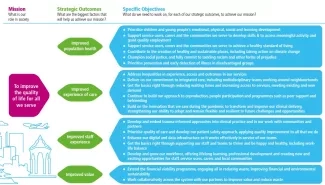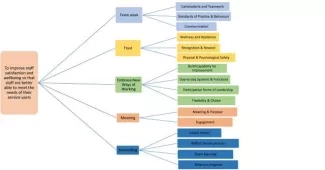Why It Matters
The East London NHS Foundation Trust (ELFT) may have won multiple awards for their quality improvement (QI) work, but as ELFT Chief Quality Officer Amar Shah, MD, noted during a recent presentation to the Institute for Healthcare Improvement (IHI) Joy in Work Results-Oriented Learning Network (ROLN), they’re always striving to do better.
ELFT offers mental health, community health, and primary care services in London, Bedfordshire, and Luton, and became an IHI Strategic Partner in 2015. According to Shah, ELFT has fully embraced using QI tools and methods to address a range of issues. For example, over the years they’ve made dramatic improvements in workforce safety, medication errors, wait times, and cost reduction.
During the years that ELFT steadily increased their use of QI throughout their system, survey feedback indicated that staff felt more satisfied and motivated. They also expressed optimism about their ability to make positive change. In a field known for high burnout and turnover, this might be surprising to many, but not Shah. “When you adopt QI, you are essentially giving people at the point of care the power to make changes to the system and providing them with support and skills to do so,” he remarked. “It’s no surprise then that people feel more empowered and able to exert some control over the system in which they work.”
Yet, ELFT leaders learned from their QI training to always look for opportunities for improvement. When they looked more deeply, they found variation in satisfaction when the data were stratified by team and by profession. Those in management, for example, reported higher staff engagement than allied health professionals.
In the following excerpts from his ROLN presentation, Shah shares valuable insights from the last four years of using QI methods and tools to address joy.
On how ELFT built upon their QI experience
We began by using our tried and tested approach to quality improvement. All our QI work is led by teams, and the teams focus on what matters most to the staff and patients. We help them identify and understand their team’s big issue before they think about how to improve the system. They come up with change ideas, a theory of change, and their aim and measures. They test ideas and implement when they know what works. We’ve applied the same approach to joy that we’ve used with other [QI projects]. It’s been helpful for our teams to realise that they’re using familiar methods and language to tackle something that feels a little bit different.
On aligning with organisational strategy

ELFT organisational strategy
Staff experience is one of our four big strategic objectives. It’s always been important to us to focus on the experience of our people as a key enabler to achieving our mission. One of the big challenges is to align this work so it’s understood as central to our approach. The Enjoying Work programme that I sponsor is just one of multiple initiatives aimed at supporting the well-being and health of our people.
On how ELFT started working on joy
It was fantastic timing that the IHI Framework for Improving Joy in Work came out at almost the same time that we were thinking about how to get underneath some of the factors that contribute to people having a good experience at work.
We started out with a 90-day cycle to help us design our approach. We did a bit of interviewing and research and developed some theories to test. When we summarised our learning, a lot of it was about language. This was important because when we first brought the joy in work white paper to our teams, there was a bit of a mixed reaction to the [phrase “joy in work.”] After we reviewed our survey responses, we ended up using the framing of “enjoying work.” It felt like an active way of describing what we were trying to achieve.
We then brought together a range of people to start creating our theory about how to enhance people’s joy in work. We built affinity diagrams to identify our big primary drivers to represent our theory of change. We used our literature search and the white paper to inform the key things to work on. We created a macro-level driver diagram.

ELFT’s Driver Diagram for Enjoying Work
On improving joy at scale
We began by identifying four teams that worked in a range of contexts (inpatient, community, co-located, and dispersed) for our first cohort. We started to learn with them about how we would apply quality improvement to this topic in a systematic way to test and measure. For the second cohort, we scaled up to 17 teams and applied the same approach. Each team developed their own theory of change and very different change ideas. However, the teams tested concepts that connected back to IHI’s theory about the big factors that contribute to joy, such as teamwork and camaraderie; meaning and purpose; reward and recognition; and participative management.
We’ve learned that you can’t really scale ideas from this work. The ideas are so local and contextual that they aren’t always directly applicable to another team. What you can scale is the approach, and that’s what we do. We’re now into our fifth cohort of teams. We’ve reached about 50 out of our 300 teams over the last three years.
On measuring joy
Measuring joy in work is one of the areas where many teams and organisations across the world struggle. Teams either overdo measurement, creating a burden, or they struggle to capture data regularly enough to understand and learn from the variation. We’ve tried to keep measurement as simple as we can. We started out with daily measurement because it’s what the teams wanted to do. But, over time, daily measurement gets quite draining. There needs to be a happy balance between collecting enough data to understand variation and focusing effort on making changes. So now, we utilise three questions on a weekly basis for all teams undertaking this work.
On the hard work of improving joy
When one of our teams told their improvement story, they chose the headline “Enjoying Work Takes Work.” We don’t want to put them off, but we prepare people at the outset that [working on joy] is hard work. Our first cohort didn’t have any organisational development support and coaching for the leaders of those teams. We learned very rapidly that — to do this work properly — the leaders of the teams need access to a safe space where they can think about [what they’re feeling and experiencing] and how they respond to it.
Starting with the second cohort, we teamed up with our organisational development colleagues and made sure leaders had access to one-on-one support if they needed it. We try as much as possible to be asset-focused in the way we do this work, but we can’t ignore that there are difficult things that need to get said, heard, and worked through when you’re talking about the “pebbles in your shoe” that are sometimes more like boulders.
On the importance of leadership participation and support
We’ve learned about the critical role of leaders in this work. We ask our leadership sponsors to be much closer to this work than they might be for typical quality improvement work. Our executive team took part in our second cohort alongside other teams. That demonstrated to the organisation that there were things that we wanted to improve about our own experience at work, and that we trusted the process to help us.
On the importance of sharing learning
For each cohort of teams undertaking this work, we build a learning system to provide support and enable sharing. Within this, we spend quite a lot of time helping teams to tell their stories in a variety of ways — through narrative, through art, or through a poem, for example. We encourage teams to stop, reflect, recognise the impact of this work, and tell their stories to themselves and to each other. Appreciating the impact that this work can have in simple but profound ways helps teams remain connected to purpose.
Sometimes people are struck by the simplicity of the ideas that seem to be making a difference, but often it’s not just the idea itself that has led to the improvement. It’s also the process that the team has gone through that has led to an enhanced sense of autonomy and connecting to what matters in their work. It’s listening to each other about what contributes to a good day at work. For me, that process may be just as efficacious in supporting joy as the ideas that teams choose to test and implement.
Editor’s note: This interview has been edited for length and clarity.
You may also be interested in:
